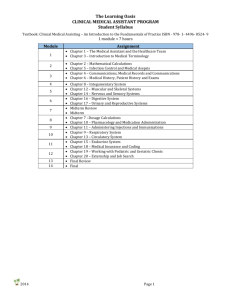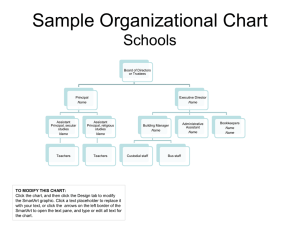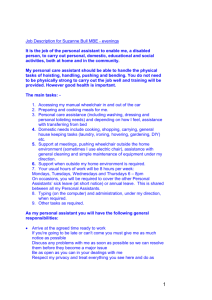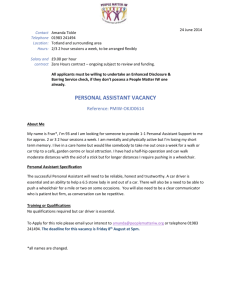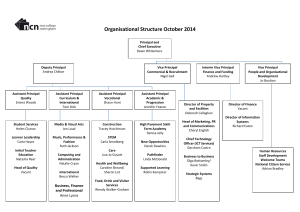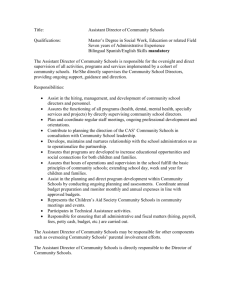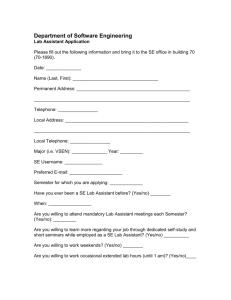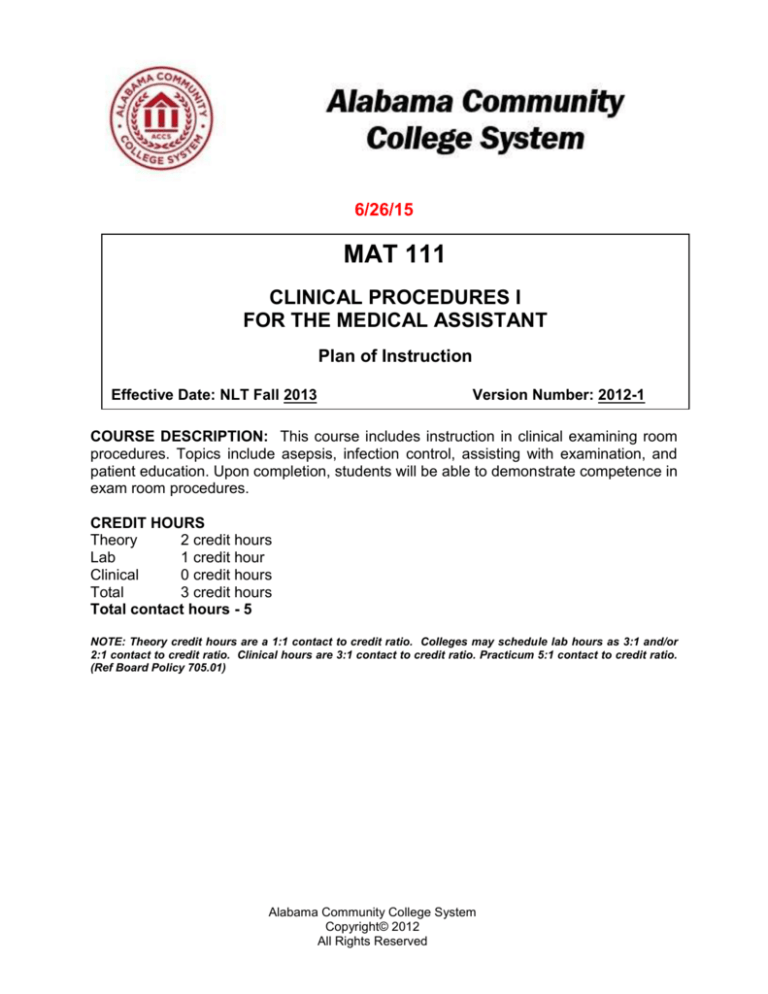
6/26/15
MAT 111
CLINICAL PROCEDURES I
FOR THE MEDICAL ASSISTANT
Plan of Instruction
Effective Date: NLT Fall 2013
Version Number: 2012-1
COURSE DESCRIPTION: This course includes instruction in clinical examining room
procedures. Topics include asepsis, infection control, assisting with examination, and
patient education. Upon completion, students will be able to demonstrate competence in
exam room procedures.
CREDIT HOURS
Theory
2 credit hours
Lab
1 credit hour
Clinical
0 credit hours
Total
3 credit hours
Total contact hours - 5
NOTE: Theory credit hours are a 1:1 contact to credit ratio. Colleges may schedule lab hours as 3:1 and/or
2:1 contact to credit ratio. Clinical hours are 3:1 contact to credit ratio. Practicum 5:1 contact to credit ratio.
(Ref Board Policy 705.01)
Alabama Community College System
Copyright© 2012
All Rights Reserved
Clinical Procedures I for the Medical Assistant
MAT 111
PREREQUISITE COURSES
None
CO-REQUISITE COURSES
None
INSTRUCTIONAL GOALS
Cognitive - Comprehend foundational knowledge of medical assisting.
Psychomotor - Apply foundational knowledge of medical assisting to perform
specified examinations and procedures.
Affective – Value the importance of following procedures associated with medical
assisting.
PROFESSIONAL COMPETENCIES
Comprehend the role of the medical assistant with infection prevention and
control.
Comprehend OSHA standards required of the medical assistant.
Comprehend the role of the medical assistant with infection prevention and
control.
Perform medical assistant responsibilities for patient preparation.
Perform medical assistant responsibilities for eye and ear examination and
procedures.
PROFESSIONAL COMPETENCIES/OBJECTIVES
Unless otherwise indicated, evaluation of student’s attainment objectives is based on
knowledge and skills gained from this course. Competencies specified for each module
may be set by certification agencies, national and state codes, health care facility
policies, locally developed lab/clinical assignments, or any combination. Students are
expected to utilize relevant technology for client care and documentation. This course
is based on current national credentialing bodies.
ACCS Copyright© 2012
All Rights Reserved
2
Clinical Procedures I for the Medical Assistant
MAT 111
STUDENT LEARNING OUTCOMES
MODULE A - MEDICAL ASEPSIS AND OSHA STANDARDS
PROFESSIONAL COMPETENCIES
A1.0
A2.0
Comprehend the role of the
medical assistant with infection
prevention and control.
Comprehend OSHA standards
required of the medical assistant.
PERFORMANCE OBJECTIVES
A1.1 Practice asepsis prevention and
control.
NOTE: This is an ongoing evaluation.
A2.1 Comply with OSHA standards for
the medical assistant.
NOTE: This is an ongoing evaluation.
SAMPLES OF BEHAVIOR:
Hand hygiene
Gloving
Sterilization
Disinfection
Patient education
Documentation
LEARNING OBJECTIVES
A1.1.1 Define terms associated with medical asepsis prevention and control.
A1.1.2 Value the importance of asepsis prevention and control.
A1.1.3 Describe common microorganisms.
A1.1.4 Explain the infectious process.
A1.1.5 Explain the consequences of infection.
A1.1.6 Describe various techniques to control infection.
A1.1.7 Discuss various common diseases and pathologies.
A1.1.8 Discuss considerations for patient education of medical asepsis.
A1.1.9 Describe documentation requirements for medical asepsis.
A2.1.1 Describe the use of Material Safety Data Sheets (MSDS).
A2.1.2 Discuss hazardous communication standards for the medical office.
A2.1.3 Identify OSHA guidelines for healthcare providers.
A2.1.4 Identify standard precautions.
MODULE A OUTLINE
Terminology
Medical asepsis
Microorganisms
o Common microorganisms
o Infectious process
o Consequences
Infection controls
o Hand hygiene
o Gloves
o Sterilization and Disinfection
Diseases and Pathologies
Patient education
Documentation
OSHA standards
MSDS
Hazardous communication standards
Guidelines for healthcare providers
Standard precautions
ACCS Copyright© 2012
All Rights Reserved
KSA
Indicators
2
2
1
A
1
2
3
2
2
2
2
2
2
1
1
3
Clinical Procedures I for the Medical Assistant
MAT 111
MODULE B - OFFICE SURGICAL ASEPSIS
PROFESSIONAL COMPETENCIES
B1.0
PERFORMANCE OBJECTIVES
Comprehend the role of the
B1.1 Practice asepsis prevention and
medical assistant with infection
control.
NOTE: This is an ongoing evaluation.
prevention and control.
SAMPLES OF BEHAVIOR:
Hand hygiene
Gloving
Sterile techniques
Disinfection
Patient education
Documentation
LEARNING OBJECTIVES
B1.1.1 Define terms associated with office surgical asepsis.
B1.1.2 Describe the types and uses of various surgical instruments.
B1.1.3 Identify types of wounds.
B1.1.4 Describe the phases of wound healing.
B1.1.5 Describe the medical assistants role in wound care.
B1.1.6 Describe responsibilities of medical assistant’s role related to minor office
surgery.
B1.1.7 Describe sterile techniques associated with surgical procedures.
B1.1.8 Describe common office surgical procedures and the medical assistant’s
role.
B1.1.9 Discuss considerations for patient education of surgical asepsis.
B1.1.10 Describe documentation requirements for surgical asepsis.
MODULE B OUTLINE
Terminology
Surgical instruments
Types
Uses
Wounds and wound healing
Types of wounds
Phases of wound healing
Wound care
o Dressing
o Suturing and suture removal
Assisting with minor office surgery
Sterile techniques
Surgical procedures
Common office surgical procedures
Medical Assistant’s roles
Patient education
Documentation
ACCS Copyright© 2012
All Rights Reserved
KSA
Indicators
2
1
2
1
1
2
2
2
2
2
2
4
Clinical Procedures I for the Medical Assistant
MAT 111
MODULE C - PATIENT PREPARATION FOR EXAM
PROFESSIONAL COMPETENCIES
C1.0
PERFORMANCE OBJECTIVES
KSA
Indicators
2
Perform medical assistant
C1.1 Assist patients with preparing for
responsibilities for patient
medical examination.
preparation.
SAMPLES OF BEHAVIOR:
Aseptic techniques
Exam room preparation
Patient preparation
Assisting the physician
Patient education
Documentation
LEARNING OBJECTIVES
C1.1.1 Define terms associated with patient examination.
C1.1.2 Describe the types and uses of various equipment, materials, and supplies used
for patient examinations.
C1.1.3 Describe the medical assistant’s role in preparing the patient for examination.
C1.1.4 Differentiate between various assessment techniques used in the physical exam.
C1.1.5 Discuss considerations for patient education for physical exams.
C1.1.6 Describe documentation requirements for physical exams.
MODULE C OUTLINE
Terminology
Preparing the exam room
Equipment
Materials and supplies
Preparing the patient
Height and weight
Positioning and draping
Assessment techniques
Patient education
Documentation
ACCS Copyright© 2012
All Rights Reserved
1
2
2
2
2
2
5
Clinical Procedures I for the Medical Assistant
MAT 111
MODULE D - EYE AND EAR EXAMINATION AND PROCEDURES
PROFESSIONAL COMPETENCIES
D1.0
PERFORMANCE OBJECTIVES
Perform medical assistant
D1.1 Perform specified eye and ear
responsibilities for eye and ear
examination and procedures.
examination and procedures.
SAMPLES OF BEHAVIOR:
Aseptic techniques
Patient preparation
Assisting the physician
Specified eye and ear exams and procedures
Patient education
Documentation
LEARNING OBJECTIVES
D1.1.1 Define terms associated with eye and ear examinations and procedures.
D1.1.2 Describe the types and uses of instruments used in eye and ear
examinations and procedures.
D1.1.3 Describe methods for performing specified eye and ear examinations and
procedures.
D1.1.4 Discuss considerations for patient education for eye and ear examinations
and procedures.
D1.1.5 Describe documentation requirements for eye and ear examinations and
procedures.
MODULE D OUTLINE
Terminology
Anatomy Review
Instruments
Procedures
Visual acuity
Auditory acuity
Instillation
Irrigation
Other
Patient education
Documentation
ACCS Copyright© 2012
All Rights Reserved
KSA
Indicators
2
1
2
2
2
2
6
Clinical Procedures I for the Medical Assistant
MAT 111
LEARNING OUTCOMES TABLE OF SPECIFICATIONS
The table below identifies the percentage of learning objectives for each module. Instructors should
develop sufficient numbers of test items at the appropriate level of evaluation.
Limited Knowledge
and Proficiency
KSA
Module A
Module B
Module C
Module D
1
33%
30%
17%
20%
Indicator
Key Terms
1
Limited
Knowledge
and
Proficiency
2
Moderate
Knowledge
and
Proficiency
3
Advanced
Knowledge
and
Proficiency
4
Superior
Knowledge
and
Proficiency
A
Affective
Objective
ACCS Copyright© 2012
All Rights Reserved
Moderate
Knowledge and
Proficiency
2
67%
70%
83%
80%
Advanced
Knowledge and
Proficiency
3
0
0
0
0
Superior
Knowledge and
Proficiency
4
0
0
0
0
Learner’s Knowledge, Skills and Abilities
Description
Recognize basic information about the subject including terms and
nomenclature.
Students must demonstrate ability to recall information such as facts,
terminology or rules related to information previously taught.
Performs simple parts of the competency. Student requires close
supervision when performing the competency.
Distinguish relationships between general principles and facts. Adopts
prescribed methodologies and concepts.
Students must demonstrate understanding of multiple facts and
principles and their relationships, and differentiate between elements
of information. Students state ideal sequence for performing task.
Performs most parts of the competency with instructor assistance as
appropriate.
Examines conditions, findings, or other relevant data to select an
appropriate response.
The ability to determine why and when a particular response is
appropriate and predict anticipated outcomes.
Students demonstrate their ability to seek additional information and
incorporate new findings into the conclusion and justify their answers.
Able and willing to perform tasks independently..
Assessing conditions, findings, data, and relevant theory to formulate
appropriate responses and develop procedures for situation resolution.
Involves higher levels of cognitive reasoning.
Requires students to formulate connections between relevant ideas
and observations.
Students apply judgments to the value of alternatives and select the
most appropriate response.
Can instruct others how to do the competency.
Performs competency quickly and accurately.
Describes learning objectives that emphasize a feeling tone, an
emotion, or a degree of acceptance or rejection.
Objectives vary from simple attention to selected phenomena to
complex but internally consistent qualities of character and conscience.
Expressed as interests, attitudes, appreciations, values, and emotional
sets or biases.
7

